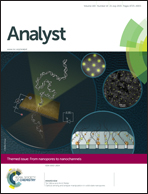Metal-enhanced fluorescence and FRET on nanohole arrays excited at angled incidence
Abstract
The influence of experimental parameters on the performance of plasmonic sensors is of great importance in analytical sciences. The plasmon coupling conditions (angle of incidence, metal composition, laser frequency and excitation/emission properties of fluorophores) were thus investigated for surface plasmon-enhanced fluorescence on metallic nanohole arrays. Optimal fluorescence enhancements were achieved when the plasmon resonance, the excitation laser and the fluorophore's excitation wavelengths were matched. The enhancement of the acceptor emission of a rhodamine 6G(Rh6G)-Quasar670™ FRET pair was achieved on the nanohole arrays by tuning the plasmon wavelength with the maximal overlap of the donor's emission and acceptor excitation. Silver nanohole arrays achieved larger fluorescence enhancement than gold nanohole arrays at 532 nm, while gold nanohole arrays led to larger fluorescence enhancement at 635 nm. These results demonstrate the importance of tuning the plasmon coupling conditions for surface plasmon-enhanced fluorescence sensing.

- This article is part of the themed collection: From nanopores to nanochannels

 Please wait while we load your content...
Please wait while we load your content...